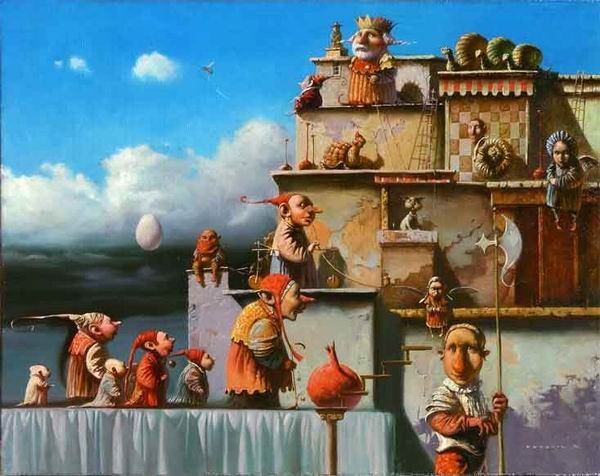
Triple Check in Chess?! Even Quadruple?! Naw, It Ain't So!
You don't believe it, I can see that. I know it IS funny, but I'm not kidding. Triple and quadruple checks ARE possible in chess. Seriously.
Well, this does happen in XiangQi, one of the Asian versions of chess![]() (pronounced something like shyang-chee), also known as Chinese, or Elephant chess. The mental Kung fu on the chessboard.
(pronounced something like shyang-chee), also known as Chinese, or Elephant chess. The mental Kung fu on the chessboard.
The name XiangQi has an interesting origin. In China, a learned person has been expected to be able to converse in four areas of performing arts: playing a musical instrument (qin), painting (hua), calligraphy (shu), and playing a strategy board game (qí). The latter term, qí, provides the final syllable of XiangQi.
XiangQi exercises the brain in much the same way as Western chess does, but it is much faster moving. It is a strategy-medium/tactics-heavy game that tends to escalate very quickly into threats, counter-threats, and checkmate situations.
There are at least two reasons explaining why XianqQi is more dynamic.
First, there are fewer pawns (five on each side), which means less obstacles for men to exert their force. Also, fewer pawns on a 9x10 board means that four verticals are cleared from Pawns right from the very beginning.
Secondly, as it is played on the 40 percent bigger 9x10 board, there is an effect for which I'm using this analogy: think of playing basketball on a soccer field. It requires much more and faster running around, doesn't it?
Because of this dynamism, some say chess players who started in Chinese chess and then switched to Western variant are excellent tacticians.

XiangQi chessboard and set
.
Cannon (Pao)
To see how triple and quadruple check work in Chinese chess, let us first familiarize ourselves with Cannon, a chess piece found exclusively in XiangQi.
The phonetic for its Chinese name is pào which sounds like the English sound effect pow and it is evident the Chinese name for Cannon is onomatopoeic.
As a chess player you know how Rook operates. In XiangQi, it is called Chariot and is the most valuable piece. [1]
Cannon, in turn, moves like Rook, any distance horizontally or vertically, but can only capture by jumping over another piece (whether a friend or enemy) along its path. This piece is called cannon platform.

Cannon can only capture by jumping over a screen
.
Horse (Mao)
XiangQi Horse is capable of moving as Knight in Western chess, but it cannot leap over pieces. When it moves, it first moves one space horizontally or vertically, followed by one more space diagonally outward (as @Zeitnot17 wrote in his post on Knight, this is exactly how Staunton defined the Knight movement, "one square in a straight line, and one in an oblique direction").
When the first intersection (XiangQi men use them, not squares) it wants to move to is occupied, its movement in that direction is blocked. So it is prevented from reaching all squares the unrestricted Western Knight can.

Possible movements of Horse in XiangQi
Since Horse in XiangQi steps to its destination instead of leaping there, as Knight does, it is also capable of pinning pieces!
.
Double check
A double check occurs when two pieces simultaneously threaten the enemy General (by the way, the name King for this piece was changed to General because China’s emperors didn’t like their royal title to be given to a game piece).
An example of the double check is Chariot/Rook checking General and acting as a platform for Cannon situated behind. This can be blocked by moving a piece between General and Rook, blocking Cannon’s fire and that of Rook’s as well.
.
Triple check
Particular to XiangQi is triple check. It arises with Cannon, Chariot/Rook, and Horse acting. Horse moves to give check by uncovering a double check from Chariot and Cannon, which uses Chariot as the platform.
Or alternatively, Chariot discovers two checks from two Horses and gives check itself.


.
Quadruple check!
Finally, quadruple check is also possible (hey, didn't I tell you that before?). It arises with 2 Horses, Chariot, and Cannon. For example, Chariot has moved, thus delivering check and exposing a triple check from Cannon and two Horses.

* * *
You did not believe me triple and quadruple check were possible, right? Well, nothing is impossible on the chessboard and beyond!
Note:
1. Western chess pays too much attention to Queen, as the most powerful piece on the board. Even worse: since Pawn can be promoted to become Queen, Western chess pays too much attention to Pawn as well, argues Prof David H. Li in Give up Western Chess – play Chinese Chess instead!. He adds neither rule makes any sense, if one views chess as a kind of war simulation game.
And I would add here that the stalemate rule is not devised after simulating war. Chinese chess is right in that regard as a stalemated General should lose the war.
Lastly, the Japanese chess (Shogi) rule that men can get back to battles after capturing might make sense if we agree chess mirrors war.
